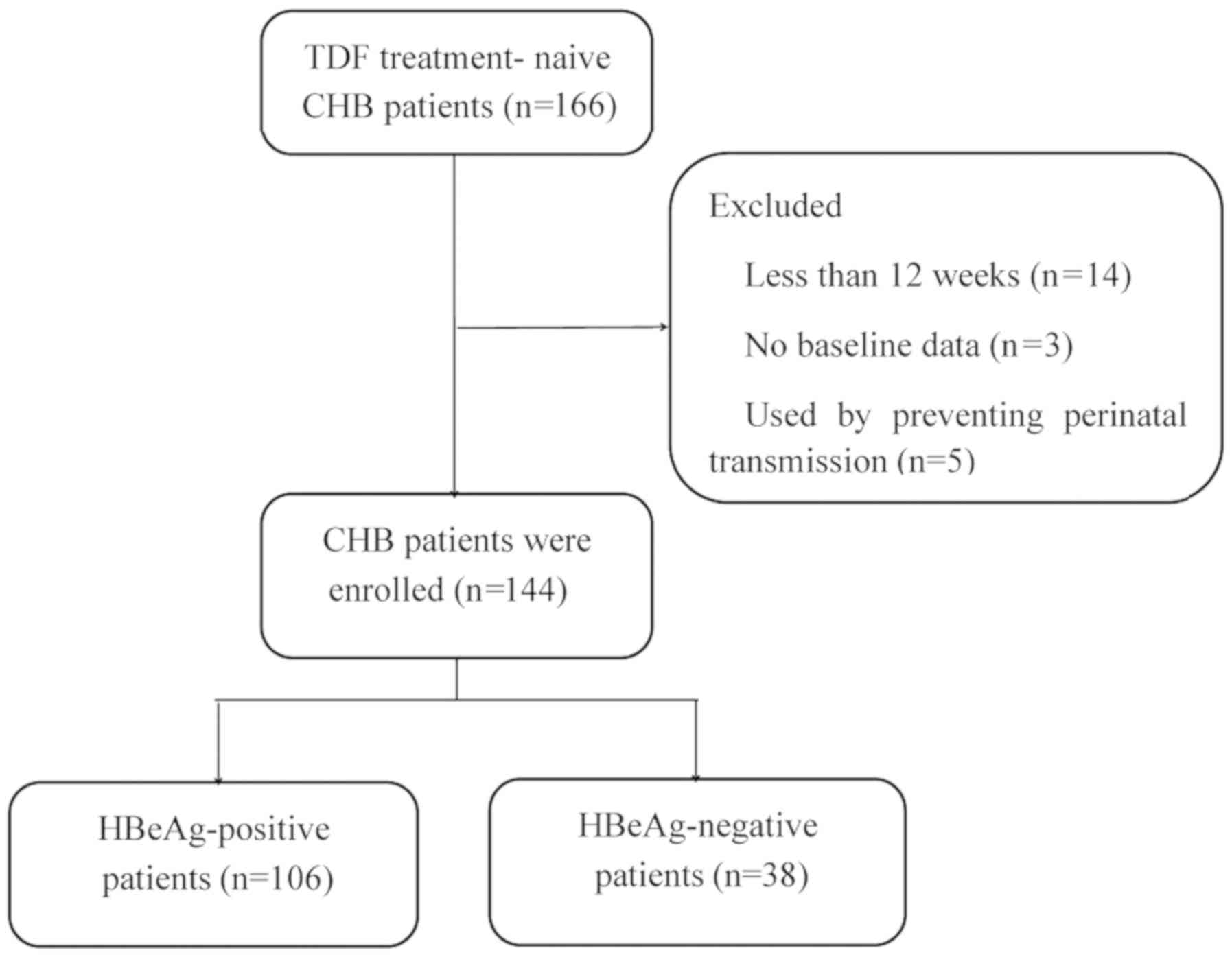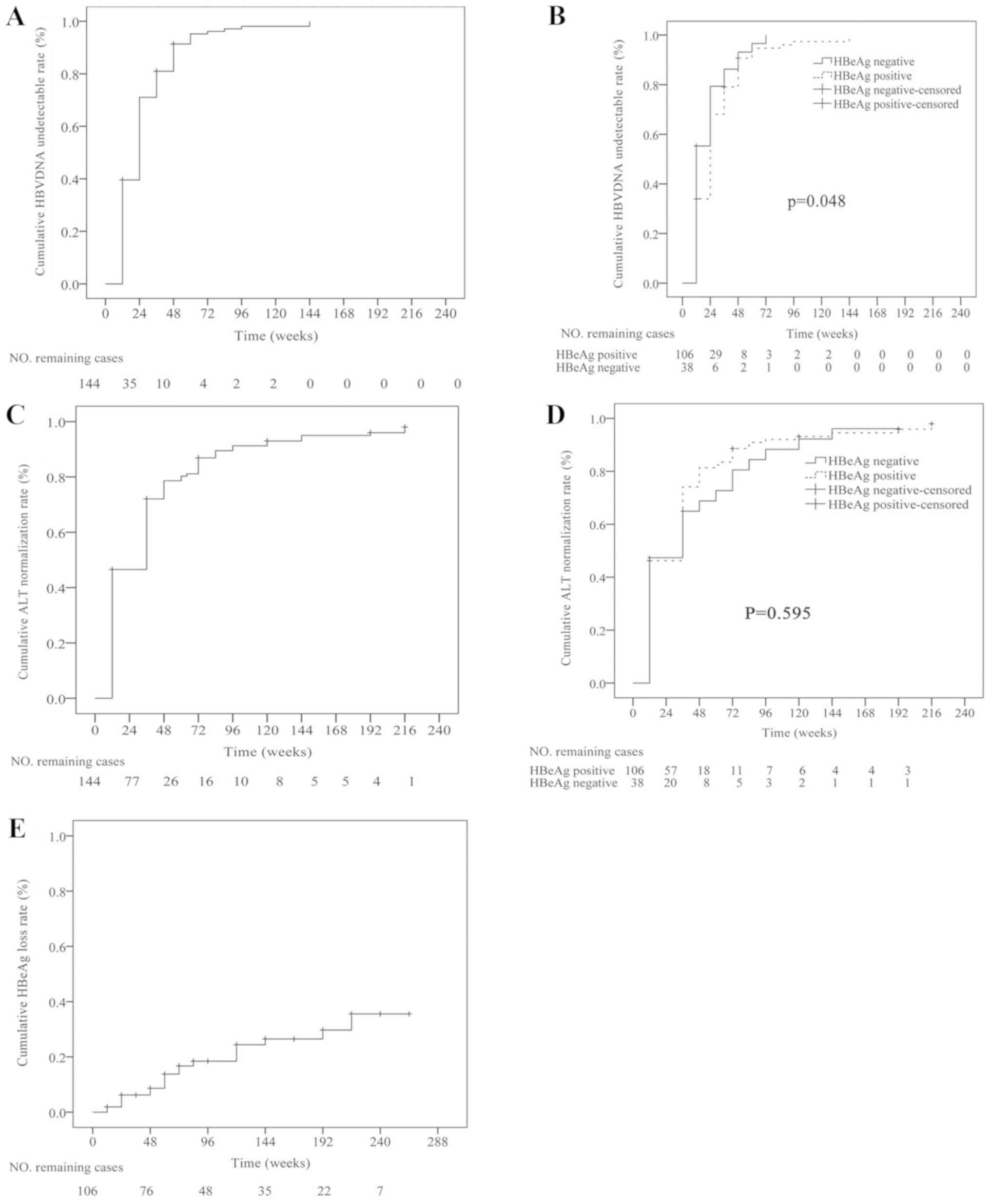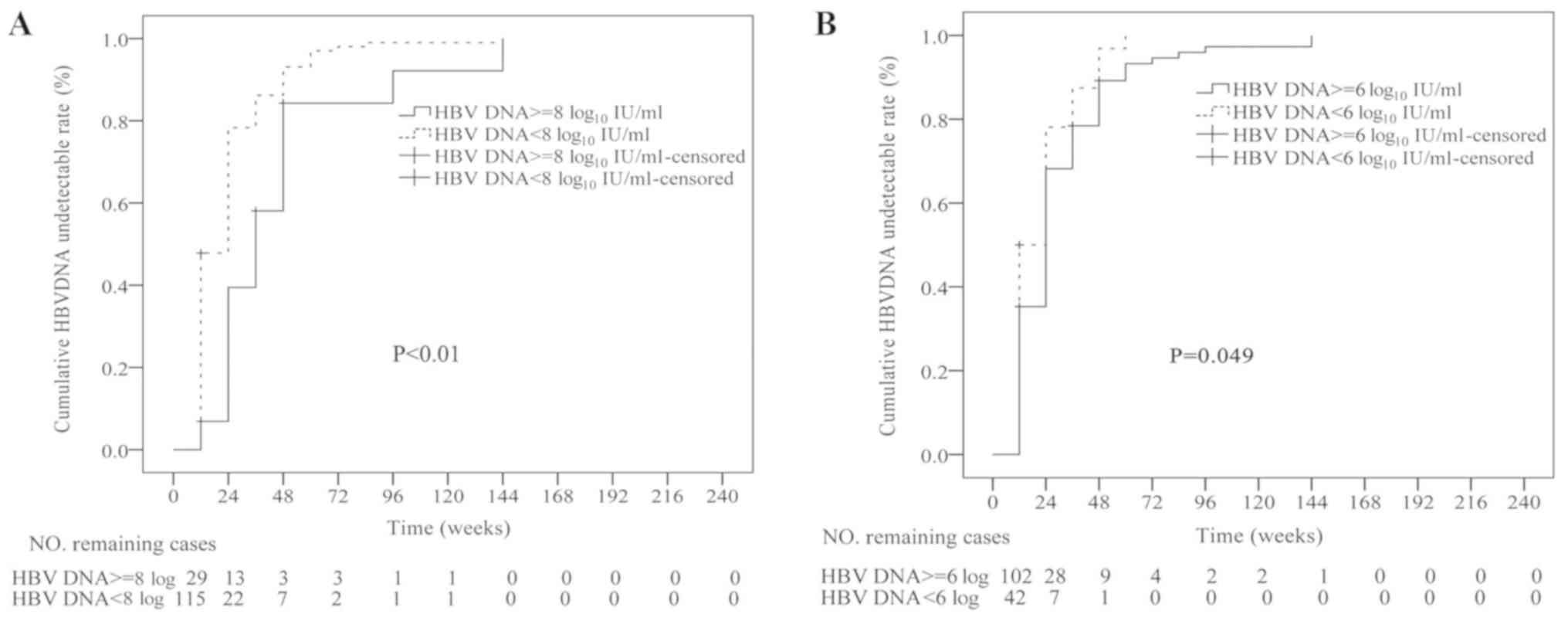|
1
|
Wang FS, Fan JG, Zhang Z, Gao B and Wang
HY: The global burden of liver disease: The major impact of China.
Hepatology. 60:2099–2108. 2014. View Article : Google Scholar : PubMed/NCBI
|
|
2
|
Chinese Society of Hepatology and Chinese
Society of Infectious Diseases, Chinese Medical Association, . The
Guideline of Prevention and Treatment for Chronic Hepatitis B (2015
Version). J Clin Hepatol. 31:1941–1960. 2015.
|
|
3
|
Marcellin P, Heathcote EJ, Buti M, Gane E,
de Man RA, Krastev Z, Gemanidis G, Lee SS, Flisiak R, Kaita K, et
al: Tenofovir disoproxil fumarate versus adefovir dipivoxil for
chronic hepatitis B. N Engl J Med. 359:2442–2455. 2008. View Article : Google Scholar : PubMed/NCBI
|
|
4
|
Buti M, Tsai N, Petersen J, Flisiak R,
Gurel S, Krastev Z, Aguilar Schall R, Flaherty JF, Martins EB,
Charuworn P, et al: Seven-year Efficacy and safety of treatment
with tenofovir disoproxil fumarate for chronic hepatitis B virus
infection. Dig Dis Sci. 60:1457–1464. 2015. View Article : Google Scholar : PubMed/NCBI
|
|
5
|
Sarin SK, Kumar M, Lau GK, Abbas Z, Chan
HL, Chen CJ, Chen DS, Chen HL, Chen PJ, Chien RN, et al:
Asian-Pacifc clinical practice guide-lines on the management of
hepatitis B: A 2015 update. Hepatol Int. 10:1–98. 2016. View Article : Google Scholar : PubMed/NCBI
|
|
6
|
Terrault NA, Bzowej NH, Chang KM, Hwang
JP, Jonas MM, Murad MH; American Association for the Study of Liver
Diseases, ; et al: AASLD guidelines for treatment of chronic
hepatitis B. Hepatology. 63:261–283. 2016. View Article : Google Scholar : PubMed/NCBI
|
|
7
|
Lampertco P, Maini M and Papatheodoridis
G: Optimal management of hepatitis B virus infection-EASL special
conference. J Hepatol. 63:1238–1253. 2015. View Article : Google Scholar : PubMed/NCBI
|
|
8
|
Liu Y, Corsa AC, But M, Cathcart AL,
Flaherty JF, Miller MD, Kitrinos KM, Marcelin P and Gane EJ: No
detectable resistance to tenofovir disoproxil fumarate in HBeAg+
and HBeAg−patents with chronic hepatts B afer 8 years of treatment.
J Viral Hepat. 24:68–74. 2016. View Article : Google Scholar : PubMed/NCBI
|
|
9
|
Lim YS, Lee YS, Gwak GY, Byun KS, Kim YJ,
Choi J, An J, Lee HC, Yoo BC and Kwon SY: Monotherapy with
tenofovir disoproxil fumarate for multiple drug-resistant chronic
hepatitis B: 3-year trial. Hepatology. 66:772–783. 2017. View Article : Google Scholar : PubMed/NCBI
|
|
10
|
Gordon SC, Krastev Z, Horban A, Petersen
J, Sperl J, Dinh P, Martins EB, Yee LJ, Flaherty JF, Kitrinos KM,
et al: Efficacy of tenofovir disoproxil fumarate at 240 weeks in
patients with chronic hepatitis B with high baseline viral load.
Hepatology. 58:505–513. 2013. View Article : Google Scholar : PubMed/NCBI
|
|
11
|
Gao L, Trinh HN, Li J and Nguyen MH:
Tenofovir is superior to entecavir for achieving complete viral
suppression in HBeAg-positive chronic hepatitis B patients with
high HBV DNA. Aliment Pharmacol Ther. 39:629–637. 2014. View Article : Google Scholar : PubMed/NCBI
|
|
12
|
Lovett GC, Nguyen T, Iser DM, Holmes JA,
Chen R, Demediuk B, Shaw G, Bell SJ, Desmond PV and Thompson AJ:
Efficacy and safety of tenofovir in chronic hepatitis B: Australian
real world experience. World J Hepatol. 9:48–56. 2017. View Article : Google Scholar : PubMed/NCBI
|
|
13
|
Ma YC, Zuo L, Chen JH, Luo Q, Yu XQ, Li Y,
Xu JS, Huang SM, Wang LN, Huang W, et al: Modified glomerular
filtration rate estimating equation for Chinese patients with
chronic kidney disease. J Am Soc Nephrol. 17:2937–2944. 2006.
View Article : Google Scholar : PubMed/NCBI
|
|
14
|
Wu IT, Hu TH, Hung CH, Lu SN, Wang JH, Lee
CM and Chen CH: Comparison of the efficacy and safety of entecavir
and tenofovir in nucleos(t)ide analogue-naive chronic hepatitis B
patients with high viraemia: A retrospective cohort study. Clin
Microbiol Infect. 23:464–469. 2017. View Article : Google Scholar : PubMed/NCBI
|
|
15
|
Lampertico P: Partial virological response
to nucleos(t)ide analogues in naïve patients with chronic hepatitis
B: From guidelines to field practice. J Hepatol. 50:644–647. 2009.
View Article : Google Scholar : PubMed/NCBI
|
|
16
|
Marcellin P, Zoulim F, Hezode C, Causse X,
Roche B, Truchi R, Pauwel A, Ouzan D, Dumortier J, Pageaux GP, et
al: Effectiveness and safety of tenofovir disoproxil fumarate in
chronic Hepatitis B: A 3-year, prospective, real-world study in
France. Dig Dis Sci. 61:3072–3083. 2016. View Article : Google Scholar : PubMed/NCBI
|
|
17
|
Hongthanakorn C, Chotiyaputta W,
Oberhelman K, Fontana RJ, Marrero JA, Licari T and Lok AS:
Virological breakthrough and resistance in patients with chronic
hepatitis B receiving nucleos(t)ide analogues in clinical practice.
Hepatology. 53:1854–1863. 2011. View Article : Google Scholar : PubMed/NCBI
|
|
18
|
European Association For The Study Of The
Liver. Electronic address, . easloffice@easloffice.eu; European
Association for the Study of the Liver: EASL 2017 Clinical Practice
Guidelines on the management of hepatitis B virus infection. J
Hepatol. 67:370–398. 2017. View Article : Google Scholar : PubMed/NCBI
|
|
19
|
Shi H, Huang M, Lin GL, Li X, Wu Y, Jie Y
and Chong Y: Efficacy comparison of tenofovir and entecavir in
HBeAg-positive chronic hepatitis B patients with high HBV DNA.
Biomed Res Int. 2016:67250732016. View Article : Google Scholar : PubMed/NCBI
|
|
20
|
Du Jeong I, Jung SW, Park BR, Lee Bu, Park
JH, Kim BG, Bang SJ, Shin JW and Park NH: Clinical course of
partial virologic response with prolonged Tenofovir therapy in
Nuclos(t)ides-naive patients with chronic hepatitis B. Dig Dis Sci.
62:2908–2914. 2017. View Article : Google Scholar : PubMed/NCBI
|
|
21
|
Zoutendijk R, Reijnders JG, Brown A,
Zoulim F, Mutimer D, Deterding K, Petersen J, Hofmann WP, Buti M,
Santantonio T, et al: Entecavir treatment for chronic hepatitis B:
Adaptation is not needed for the majority of naive patients with a
partial virological response. Hepatology. 54:443–451. 2011.
View Article : Google Scholar : PubMed/NCBI
|
|
22
|
European Association for the Study of the
Liver, . EASL clinical practice guide-lines: Management of chronic
hepatitis B. J Hepatol. 50:227–242. 2009. View Article : Google Scholar : PubMed/NCBI
|
|
23
|
Luo J, Li X, Wu Y, Lin G, Pang Y, Zhang X,
Ao Y, Du Z, Zhao Z and Chong Y: Efficacy of entecavir treatment for
up to 5 years in Nucleos(t)ide-naïve chronic hepatitis B patients
in real life. Int J Med Sci. 10:427–433. 2013. View Article : Google Scholar : PubMed/NCBI
|
|
24
|
Tsai MC, Chen CH, Tseng PL, Hung CH, Chiu
KW, Wang JH, Lu SN, Lee CM, Chang KC, Yen YH, et al: Comparison of
renal safety and efficacy of telbivudine, entecavir and tenofovir
treatment in chronic hepatitis B patients: Real world experience.
Clin Microbiol Infect. 22:95.e1–e7. 2016. View Article : Google Scholar
|
|
25
|
Wang HM, Hung CH, Lee CM, Lu SN, Wang JH,
Yen YH, Kee KM, Chang KC, Tseeng PL, Hu TH and Chen CH: Three-year
efficacy and safety of tenofovir in nucleos(t)ide analog-naïve and
nucleos(t)ide analog-experienced chronic hepatitis B patients. J
Gastroenterol Hepatol. 31:1307–1314. 2016. View Article : Google Scholar : PubMed/NCBI
|
|
26
|
López Centeno B, Collado Borrell R, Pérez
Encinas M, Gutierrez Garcia ML and Sanmartin Fenollera P:
Comparison of the effectiveness and renal safety of tenofovir
versus entecavir in patients with chronic hepatitis B. Farm Hosp.
40:279–286. 2016.PubMed/NCBI
|
|
27
|
Park J, Jung KS, Lee HW, Kim BK, Kim SU,
Kim DY, Ahn SH, Han KH and Park JY: Effects of entecavir and
tenofovir on renal function in patients with hepatitis B
virus-related compensated and decompensated cirrhosis. Gut Liver.
11:828–834. 2017. View
Article : Google Scholar : PubMed/NCBI
|

















